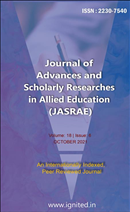A Study of the Natural Immune Reaction to Mycobacterial Isolates of Human
Examining the Role of Interferons in Tuberculosis and Therapy Response
Keywords:
Mycobacterium tuberculosis, TB, immune reaction, IFN, pulmonary tuberculosis, extra pulmonary tuberculosis, intracellular bacterial burden, Real-time PCR, ELISA, Interleukin-1β, Prostaglandin E2, therapy response, acid-fast bacilliAbstract
Mycobacterium tuberculosis (M. tb) causes TB and kills millions worldwide. Immune-dependenttissue-damaging inflammation promotes aerosol transmission, making this disease ubiquitous. SinceType I IFNs play a debatable role in TB and their induction precedes clinical tuberculosis in patients, thisstudy sought to identify a pattern (absolute levels and relative ratios) in interferon and regulatory moleculeexpression levels that correspond with TB patients and pulmonary versus extra pulmonary TB. Using an invitro M. tb THP-1 infection model and antibody-based neutralization of specific interferons, we found thatmodulating interferon production promotes intracellular bacterial burden or clearance.Real-time PCR was performed to compare IFN alpha, beta, and gamma fold mRNA expression in 123untreated TB patients (PTB - 56 EPTB - 67) and 86 healthy family contacts clinically clear of TB. EPTBand PTB patients' three IFN expression levels were compared. ELISA for Interleukin-1β, -1α, andProstaglandin E2 was done on sera from 62 TB patients and 18 healthy contacts from the sameresidence.TB patients expressed more IFN-α than counterparts. IFN-α had the highest median fold mRNAexpression (0.80) in untreated TB patients. PTB patients had a median fold mRNA expression level ofIFN- (0.87) that was higher than EPTB patients'. EPTB patients expressed 0.81 times more IFN-α thanPTB patients. The three IFNs were measured in matched samples from each patient at enrolment andafter treatment. IFN-β and IFN- reduced considerably after therapy. IFN-α high or IFN-β low patients andcontacts were then identified. All samples tested by ELISA had IFN- levels below detection. Every samplehas PGE2. IL-1 detection vary. PGE2 and IFN- levels were found inversely correlated. These data suggestmeasuring type I IFNs may help monitor therapy response. The pattern of IFNs in patients (host factors)and the identification of acid-fast bacilli (AFB) by conventional smear microscopy (mycobacterialfactors) are expected to occur earlier and precede mycobacterial load reduction.Published
2021-10-01
How to Cite
[1]
“A Study of the Natural Immune Reaction to Mycobacterial Isolates of Human: Examining the Role of Interferons in Tuberculosis and Therapy Response”, JASRAE, vol. 18, no. 6, pp. 406–412, Oct. 2021, Accessed: Jul. 02, 2024. [Online]. Available: https://ignited.in/jasrae/article/view/13576
Issue
Section
Articles
How to Cite
[1]
“A Study of the Natural Immune Reaction to Mycobacterial Isolates of Human: Examining the Role of Interferons in Tuberculosis and Therapy Response”, JASRAE, vol. 18, no. 6, pp. 406–412, Oct. 2021, Accessed: Jul. 02, 2024. [Online]. Available: https://ignited.in/jasrae/article/view/13576








